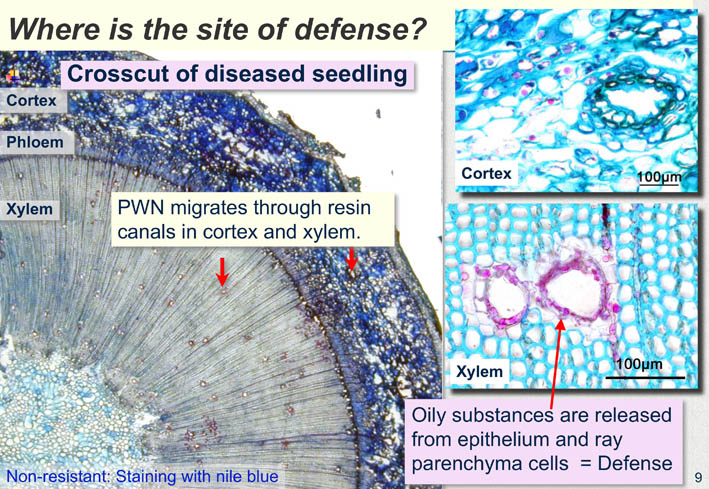INTERNATIONAL SYMPOSIUM
Pine wilt disease: a worldwide threat to forest ecosystems. 10-14 July 2006, Lisbon, Portugal
Abstract p.47
Defense systems of Pinus densiflora cultivars
selected as resistant to pine wilt
Keiko Kuroda
In
the stems of pine species resistant to pine wilt, such as Pinus taeda
and P. strobes growing in North America, migration and propagation of
the pine wood nematode (PWN) are suppressed and the nematodes disappear
from pine tissue (Kuroda et al. 1991) in contrast to the highly
susceptible Japanese pine species, P. thunbergii and P.
densiflora. Resistant cultivars (families) of these susceptible
species have been found in heavily damaged forests. Although they
are expected as savers of pine forests in Japan, certain proportions of
seedlings obtained from those cultivars are susceptible and are killed
after infection. To obtain reliable seedlings with stable high
resistance, it is important to find some criteria that can be used to
select really resistant trees for seed orchards.
In the
tissue of resistant cultivars, there must be systems that prevent
nematode activities even if the effect is weaker than those in P. taeda
(Kuroda 2004). The initial migration of PWN in the shoots was
investigated on the cuttings of non-resistant and resistant cultivars
of P. densiflora and was compared with that in P. taeda. PWN was
inoculated on the apices of 20cm long cuttings. Every day or two,
cuttings of each cultivar were cut into short segments (less than
5cm). Nematodes were extracted from each segment and were
counted. PWN in the cortex and xylem tissue was counted
separately for the cuttings of P. densiflora. Then the anatomical
characteristics were investigated on seedlings inoculated with PWN.
In P. taeda cuttings, the PWN distribution was restricted
to the inoculated area during 4 days from inoculation. On the
other hand, suppression of the nematode migration was not detected in
resistant cultivars of P. densiflora judging from the PWN numbers in
each stem segment. When PWN population in xylem tissue was
compared, a tendency was detected: In resistant cultivars, PWN
populations during 5 days from inoculation were smaller in the area
more than 5cm below from inoculated sites. In contrast, PWN
population in cortex indicates no specific tendency in resistant
cultivars. These results suggested the xylem tissue contributes
to the defense system in the early period of infection although it is
not yet clear whether the structural barrier is effective or toxic
substances exist in xylem. 
